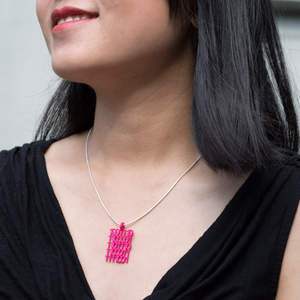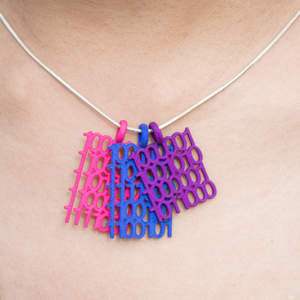There is seemingly no end to the forms that can be produced using 3D printing. The ability of 3D printers to produce objects with a high degree of precision and out of a wide variety of materials at a fairly small scale makes them an ideal mechanism for the production of detailed work such as jewelry. Mixee Labs‘ latest in-house offering is a binary code pendant created from the buyer’s personal message. This isn’t the first time that Mixee has turned to the world of science and engineering as a rich minefield for forms. Previously, they have produced pendants ranging from molecular formulas to models of quarks.
Mixee Labs is home to a pantheon of fun and quirky 3D printed projects, each capitalizing on the possibilities present in the medium of 3D printing for customization. One of their signature offerings is a Mixee Me doll (available in both standard and bobble head variety) which allows a person to model themselves by selecting from sets of features and fashion, and then be 3D printed into being. Not all of their products are created by Mixee; in fact, a wide variety of the offerings on their site are created and offered by independent artisans and entrepreneurs.
With just a quick look at the background of the founders of Mixee Labs, it’s easy to see why science and technology feature on such a grand scale in everything from the very concept of the business to the individual objects it produces. Co-founders Aaron Barnet and Nancy Liang are both talented designers with an artistic vision; Barnet has a background in computer science, while Liang comes from the world of cognitive science.
 The binary code pendants are an artful combination of those content areas and the current production methods of Mixee Labs. Binary code is a computer language that uses the digits 0 and 1 to give instructions to a computer’s processor. The binary number system was developed well before computers were machines requiring numeric inputs. Its creator, Gottfried Leibniz, first introduced the idea to the West in an article published in 1679 although it had been in use in Chinese philosophical systems many centuries earlier. Currently, the most common binary coding systems are the American Standard Code for Information Interchange (ASCII) which uses a 7-bit code and the Binary-Coded Decimal (BCD) which was designed to address decimals.
The binary code pendants are an artful combination of those content areas and the current production methods of Mixee Labs. Binary code is a computer language that uses the digits 0 and 1 to give instructions to a computer’s processor. The binary number system was developed well before computers were machines requiring numeric inputs. Its creator, Gottfried Leibniz, first introduced the idea to the West in an article published in 1679 although it had been in use in Chinese philosophical systems many centuries earlier. Currently, the most common binary coding systems are the American Standard Code for Information Interchange (ASCII) which uses a 7-bit code and the Binary-Coded Decimal (BCD) which was designed to address decimals.
To create your own bit of binary jewelry, Mixee Labs lets you type in a personalized message of up to 8 letters in length and gives you a preview of that message as it will be created in binary. The pendant can be printed in black, white, purple, red, blue, or pink and comes with a non-3D printed silver plated necklace chain. The final produce is created using laser sintered nylon plastic, giving it a matte and lightly textured finish.
This more than just a fun way for code lovers to express themselves, it’s another demonstration of the possibilities present when 3D printing comes together with imagination.
What would you want to say in binary? Let us know if you like these necklaces over at the 3D Printed Binary Code Necklace forum thread at 3DPB.com.
Subscribe to Our Email Newsletter
Stay up-to-date on all the latest news from the 3D printing industry and receive information and offers from third party vendors.
You May Also Like
Gorilla Sports GE’s First 3D Printed Titanium Cast
How do you help a gorilla with a broken arm? Sounds like the start of a bad joke a zookeeper might tell, but it’s an actual dilemma recently faced by...
Nylon 3D Printed Parts Made More Functional with Coatings & Colors
Parts 3D printed from polyamide (PA, Nylon) 12 using powder bed fusion (PBF) are a mainstay in the additive manufacturing (AM) industry. While post-finishing processes have improved the porosity of...
$25M to Back Sintavia’s Largest Expansion of Metal 3D Printing Capacity Since 2019
Sintavia, the digital manufacturing company specializing in mission-critical parts for strategic sectors, announced a $25 million investment to increase its production capacity, the largest expansion to its operations since 2019....
Velo3D Initiates Public Offering in a Bid to Strengthen Financial Foundations and Drive Future Growth
Velo3D (NYSE: VLD) has been among a number of publicly traded 3D printing firms that have attempted to weather the current macroeconomic climate. After posting a challenging financial report for 2023,...


































